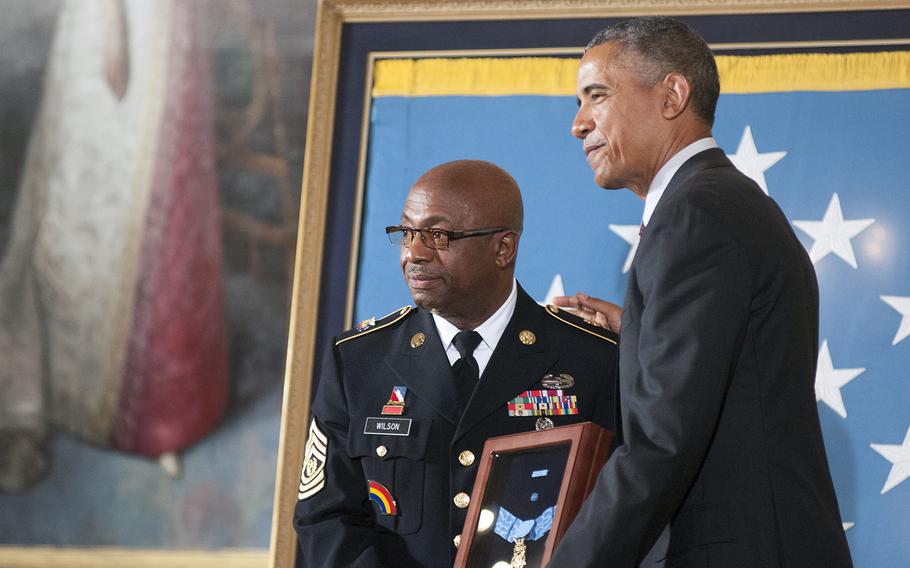
Command Sgt. Maj. Louis Wilson, the top enlisted soldier of the New York Army National Guard, receives the Medal of Honor on behalf of Army Private Henry Johnson, a veteran of World War I, who was awarded the nation's highest military honor posthumously at the White House on Tuesday, June 2, 2015, from President Barack Obama. (Carlos Bongioanni/Stars and Stripes)
They were among the bravest who fought the Germans in the hellish War to End All Wars in Europe, but for nearly a century their legacy has been obscured by discrimination.
Sgt. William Shemin and Pvt. Henry Johnson finally received the country’s highest military award June 2 when President Barack Obama bestowed each of the World War I infantry soldiers with the Medal of Honor during a ceremony at the White House.
Shemin, a 19-year-old Jewish platoon sergeant, and Johnson, a member of the all-black Harlem Hellfighters infantry unit, both were wounded while repelling German forces and protecting fellow soldiers during an Allied offensive in 1918 that led to the end of the war.
Shemin, who died in 1973, was given the Distinguished Service Cross after the war. Johnson received a Purple Heart 77 years after his combat. For years, Jewish and African-American groups said the men deserved the Medal of Honor.
“They both risked their lives to save the lives of others. They both left us decades ago, before we could give them the full recognition they deserve,” Obama said. “But it is never too late to say thank you.”
Shemin’s daughter Elsie Shemin-Roth, 86, of Webster Groves, Mo., worked for 13 years to have her father honored with the medal and was helped onto the stage from her wheelchair for the ceremony with Obama. Her sister Ina Bass, 83, joined her onstage.
William Shemin was a talented athlete who played semi-professional baseball as a teen in New Jersey. He joined the military in 1917 — although he did not meet the age requirement — months after the United States entered the war in Europe.
“Too young to enlist? No problem. He pumped up his chest and lied about his age,” Obama said.
He became a rifleman in the 4th Infantry Division and was sent to the Western Front to fight in the Second Battle of the Marne, part of a massive offensive by France, the United States and Britain.
In August 1918, his platoon was locked in trench warfare with German forces across a 150-yard stretch of no man’s land — the ground between two opposing trenches — in northern France. Shemin watched as his fellow soldiers were mowed down by machine-gun fire and the stretch of barren earth became a “blood bath,” Obama said.
“Those still in the trenches were left with a terrible choice — die trying to rescue your fellow soldier or watch him die knowing that a part of you will die along with him,” he said. “William Shemin couldn’t stand to watch. He ran out into the hell of no man’s land and dragged a wounded comrade to safety and then he did it again, and again.”
The fighting lasted days, killing officers and noncommissioned officers in the unit and leaving Shemin to take command. He reorganized the platoon’s squads and led rescue missions for the wounded during lulls in combat.
During the battle, Shemin was shot through the helmet by a machine gun and the bullet was lodged in his head behind his ear. He was hospitalized for three months but survived the war.
In 1919, he was given the Distinguished Service Cross. He was a business owner in the Bronx, N.Y., until he died in 1973.
Henry Johnson, who earned the nickname “Black Death,” was not so lucky.
He joined the all-black 369th Infantry Regiment in 1917 and a year later was shipped off to France, where Europe had been locked in a terrifying form of mechanized war for years.
Most black units were used for labor and kept from combat. But the U.S. gave command of Johnson’s unit to the French military and sent the men to the Argonne Forest in northeastern France for the Allied offensive.
Johnson and a fellow soldier, with their French helmets and weapons, were put on late-night guard duty by their French superiors, according to an account by the Smithsonian Institution. In the night, they came under sniper fire that soon became a full-out German assault.
The German forces — at least a dozen — cut the perimeter wire and flooded in, gravely wounding the other soldier. Johnson lobbed grenades until he ran out and was shot in the head, lip and side. He fired on the Germans until his rifle jammed and then used it as a club in hand-to-hand combat until the stock splintered.
The German troops knocked Johnson down with a blow to the head and tried to take his wounded fellow soldier. But Johnson rose up and attacked, killing an enemy officer and a soldier. He dragged his comrade to safety as American and French forces came to the rescue.
Johnson’s life spiraled into alcoholism after the war. He died destitute a decade later at 32 and was buried in Arlington National Cemetery.
“America can’t change what happened to Henry Johnson. … But we can do our best to make it right,” Obama said.